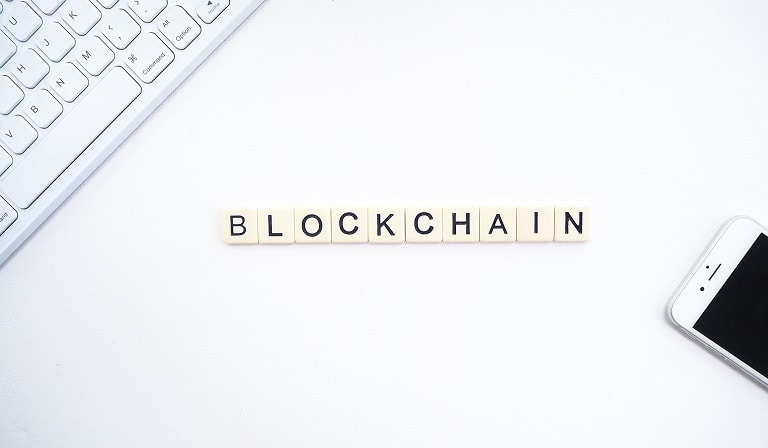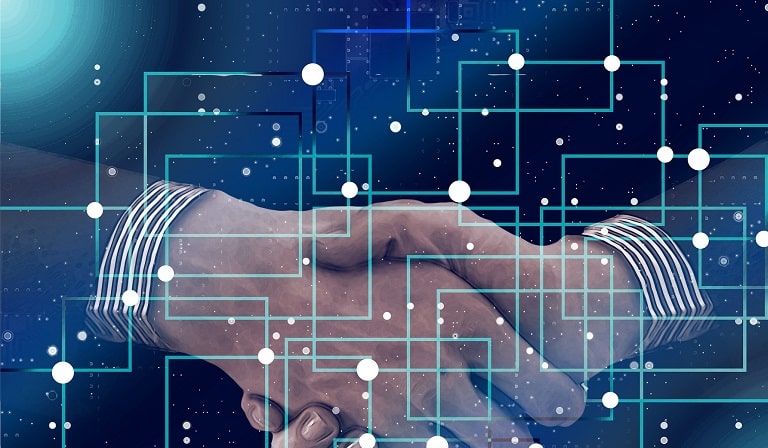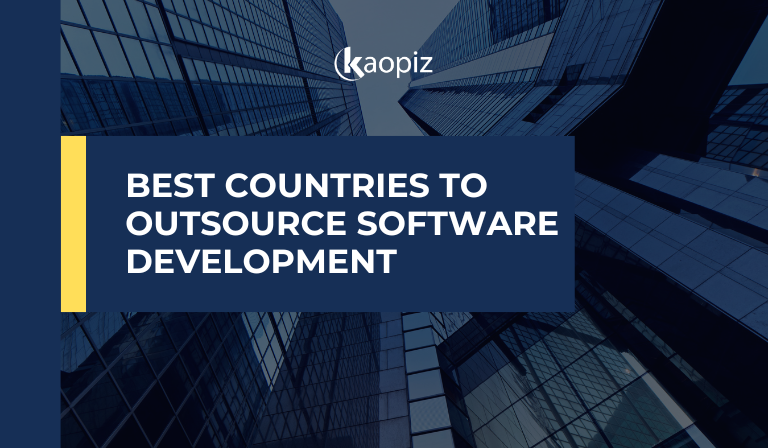In recent years, there has been a growing trend in the development of applications utilizing blockchain technology. However, as it is a relatively new technology, specific development methods are not widely known yet.
In this article, Kaopiz will explain the development methods and use cases for those who are interested in blockchain app development. Hope this information will give you a more thorough understanding of blockchain and help you smoothly progress in your development endeavors.
Table of Contents
1. What is Blockchain?

Blockchain is a technology that connects “blocks” (encrypted transaction records) in a “chain-like” manner to manage data. Data managed by blockchain is guaranteed for its legitimacy, leading to widespread applications in various fields.
1.1. Three Characteristics of Blockchain
Blockchain has three main characteristics:
・Resistance to Forgery and Cheating
・Resilience to System Downtime
・No Need for Dominance by Giant Corporations
Thanks to its technical immutability, the encrypted data on the blockchain ensures highly reliable transactions. Activities like data forgery and cheating in games experience significant reduction, while the decentralized management of data across multiple locations ensures minimal chances of system downtimes As a result, there is no longer a need for government or control by large companies, allowing the development of open services.
1.2. Evolution of Blockchain Technology
The Blockchain technology has evolved constantly since its introduction in 2008:
・Technology for Bitcoin: Blockchain 1.0
・Utilization in Various Industries: Blockchain 2.0
・Blockchainization of Applications: Blockchain 3.0
The original purpose of inventing blockchain technology was to bring about the existence of the cryptocurrency Bitcoin (BTC). Subsequently, experts found that its security and reliability were suitable for various types of data, leading to the widespread embrace of blockchain technology across diverse industries. Currently, blockchain technology is also being applied to applications, enabling the realization of “DApps” (Decentralized Applications) and “smart contracts.”
DApps (Decentralized Applications):
Applications that run on a decentralized network, with data managed on the blockchain. They often feature smart contract functionality.
Smart Contracts (Automated Contracts):
The blockchain technology blockchainizes traditional contract procedures, allowing for automatic contract fulfillment. And the prevention of tampering with the contract procedures helps in avoiding fraud and payment issues.
2. Blockchain and Web3.0?

Currently, the concentration of wealth and power in major tech companies like GAFA (*) and social media companies has become a significant issue. All content uploaded by users is tightly controlled and placed under the management of these companies.
In Web3.0, there is a movement to break free from this situation by decentralizing services into DApps (Decentralized Applications). Services that have been decentralized as DApps are developed collaboratively in an open-source manner, free from the dominance of major tech companies like GAFA. Through smart contracts, users who upload content receive rewards from viewers, leading to the realization of a society where profits are distributed fairly.
(*) GAFA: Acronym for Google, Apple, Facebook (now Meta), and Amazon, representing the four major tech companies.
3. What is a Blockchain App?

A blockchain app refers to applications that utilize blockchain 2.0 and 3.0 technologies. Here, we’ll explain the types of blockchain apps and their public scopes.
3.1. Three Types of Blockchain Apps
The main forms of blockchain apps are as follows:
・Web Apps
Apps that are accessed through a web browser. The advantage is that they can be used from any device—PC, smartphone, or tablet—as long as the browser is installed.
・PC Apps:
Installed on a computer, utilizing the full capacity of the computer’s CPU and memory.
・Mobile Apps:
Conveniently used anytime, anywhere on smartphones, leading to an increasing number of developments by companies in recent years.
Since the development methods and costs vary depending on the type of app, it’s advisable to consider beforehand which form is suitable for deploying the service.
3.2. Three Public Scope Levels of Blockchain Apps
The public scope of blockchain apps can be broadly categorized into three forms. Choose the one that aligns with the purpose and characteristics of your app:
・Public (General Public):
Public blockchain apps are open to anyone worldwide. Anyone can view or add transaction records.
・Consortium (Within a Community):
Consortium blockchain apps are limited to participation by multiple companies within a community. Only members of the community can access transaction records.
・Private (Within an Organization):
Private blockchain apps have the limitation to the specific participation by a single organization, such as a company. Only individuals authorized by the organization can access transaction records.
4. Three Benefits of Blockchain Apps

What are the benefits of blockchain apps? Blockchain apps offer several advantages not found in traditional apps. Here, we’ll demonstrate three key advantages:
・Legitimacy and Transparency:
Attempting to tamper with transaction history on the blockchain would require modifying all distributed information, practically an impossible task. Therefore, data on the blockchain is always guaranteed for legitimacy and transparency.
・Traceability (Preventing Fraud):
Recording the distribution process of products like food on the blockchain enables accurate tracking from production to sale. Since transaction history on the blockchain cannot be altered later, it prevents fraudulent activities, ensuring a safe and secure distribution process.
・Reduction in Contract Costs:
Traditional contracts, often on paper, involved human errors and significant costs for contract fulfillment. However, introducing smart contracts in DApps automates the entire contract process, leading to substantial cost savings.
5. Use Cases of Blockchain App Development

In recent years, blockchain apps have been applied in various fields. Here, we’ll introduce examples from three representative industries:
・Financial Industry:
In the financial industry, a new service called “DeFi (Decentralized Finance)” is gaining popularity. DeFi, built on blockchain, refers to financial services that operate without intermediaries like banks. DeFi offers the advantage of direct user-to-user transactions without intermediary fees.
・Gaming Industry:
The gaming industry has seen the release of numerous games known as “NFT games.” NFT, or Non-Fungible Token, refers to unique digital data managed on the blockchain. By turning in-game items into NFTs, they gain asset value, and buying and selling occur in NFT marketplaces.
・Entertainment Industry:
In the entertainment industry, efforts are being made to manage copyright data on the blockchain. This ensures fair compensation for artists and successfully reduces the processing costs of copyright management.
6. Methods for Blockchain App Development

How do you develop a blockchain app? Typically, blockchain app development requires proficiency in the following four areas of skills:
6.1. Programming Languages:
Solidity, a programming language used to write smart contracts for DApps and can be executed on the Ethereum platform, is a common technology stack in DApps development. It has syntax similar to C++, making it easier to understand if you have experience with general programming languages.
6.2. Blockchain Platforms:
In blockchain app development, using blockchain-specific platforms can shorten the development period. Some representative blockchain platforms, all of which are open source, include:
・Hyperledger Fabric
・Ethereum
・Corda
・Quorum
In general, it’s better to choose the optimal platform based on the app’s requirements, such as processing speed and public scope.
6.3. Application Frameworks:
Applications have different development environments depending on their type. Recently, the use of frameworks, templates for development, has facilitated efficient development.
Frameworks for web apps include
・Laravel
・Ruby on Rails
・Django
Frameworks for mobile apps include
・React Native
・Flutter
・Apache Cordova.
6.4. BaaS (Blockchain as a Service):
BaaS stands for “Blockchain as a Service,” providing blockchain services through cloud computing. Using BaaS makes it easy to set up the environment necessary for a blockchain app, allowing for efficient development. Representative BaaS services include AWS (Amazon Web Services) and Microsoft Azure.
7. Challenges in Blockchain App Development

Because blockchain is a relatively new technology, it faces challenges such as:
・Limited Availability of Blockchain Experts:
Due to the relatively new nature of blockchain technology, there is a shortage of professionals with expertise in blockchain. This can lead to project delays, especially in non-IT companies lacking knowledgeable personnel.
・Shortage of Development Engineers:
There is a significant shortage of blockchain engineers, making recruitment and talent acquisition challenging. As a means to address this chronic shortage, offshore development, outsourcing to overseas development companies, is a preferable solution.
8. Conclusion
In this discussion, we explained the process of blockchain app development.
・Impossibility of data tampering in blockchain apps
・Wide adoption of apps in various industries
・Challenges of talent and engineer shortages
By enhancing service reliability and adapting to Web3.0, the introduction of blockchain apps brings advantages such as cost reduction and the possibility to acquire new users. Kaopiz is available to discuss any inquiries related to blockchain app development. If you’re interested in blockchain apps, feel free to contact us.



























